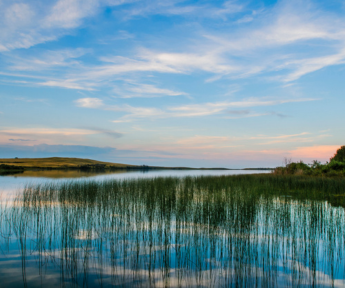Abstract
In many regions, a tradeoff exists between draining wetlands to support the expansion of agricultural land, and conserving wetlands to maintain their valuable ecosystem services. Decisions about wetland drainage are often made without identifying the impacts on the services these systems provide. We address this gap through a novel assessment of impacts on ecosystem services via wetland drainage in the Canadian prairie landscape. Draining pothole wetlands has large impacts, but sensitivity varies among the indicators considered. Loss of water storage increased the magnitude of median annual flows, but absolute increases with drainage were higher for larger, less frequent events. Total phosphorus exports increased in concert with streamflow. Our analysis suggested disproportionate riparian habitat losses with the first 30% of wetland area drained. Dabbling ducks and wetland-associated bird abundances respond strongly to the loss of small wetland ponds; abundances were predicted to decrease by half with the loss of only 20%–40% of wetland area. This approach to evaluating changes to key wetland ecosystem services in a large region where wetland drainage is ongoing can be used with an economic valuation of the drainage impacts, which should be weighed against the benefits associated with agricultural expansion.
Introduction
In the 21st century, with a growing global population, expectations of increased food production, and heightened stressors on the Earth's systems, well-reasoned land management decisions are increasingly important. Compelling evidence that multiple planetary boundaries are exceeded or at risk of being exceeded (Steffen et al. 2015) suggests that transformative management approaches are urgently needed. Agricultural land use has received much attention in this context (e.g., Foley et al. 2005), and it has been argued that food production must grow while concomitantly decreasing the industry's environmental footprint (Foley et al. 2011). The potential for tradeoffs between food production (e.g., food, forage) and underlying natural ecosystem services (e.g., pollination, carbon sequestration, hydrological services), as well as the risk of agricultural practices contributing to disservices (e.g., habitat loss, erosion) in agricultural ecosystems (Power 2010), are important considerations.
The Prairie region of Canada is part of one of the world's major food-producing regions, where more than 40 million ha are used as pasture or cropland, and agricultural practices continually evolve. Past practice changes include the adoption of no-till and reduced tillage to address issues of erosion and soil health (Awada et al. 2014), but the region is not immune to the challenges of balancing food production with other ecosystem services. Water security challenges in the region abound (Gober and Wheater 2014). There is a long history of increasing farm size, despite limited change in total farm area (Statistics Canada 2022), and farm equipment has also increased in size. Removing wetlands to increase arable land is a long-standing practice that was incentivized by early government programs (Stunden Bower 2011); declining wetland coverage has been documented many times since (Watmough and Schmoll 2007; Davidson 2014). Wetland drainage continues—annual loss rates in the region are on the order of 10 800 ha year−1 (Watmough et al. 2017)—in part because of the nuisance costs (De Laporte 2014) of navigating larger equipment around the once ubiquitous small pothole wetland ponds. Drainage impacts on surface hydrology and groundwater recharge, biogeochemical flows, and biodiversity in the region have been documented (Baulch et al. 2021), yet pragmatic, place-based approaches are needed to understand the magnitude of effects and inform decisions around wetland drainage in the region.


